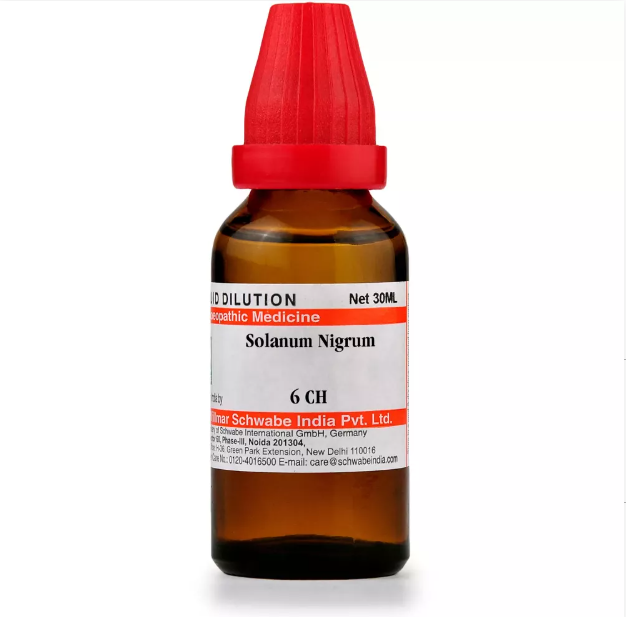SOLANUM NIGRUM Q, 6C, 12C, 30C, 200C, 1M, 10M USES AND SYMPTOMS
 SOLANUM NIGRUM
SOLANUM NIGRUM
(Black Nightshade)
Sol-n.
Effective for ergotism, tetanic spasms, body stiffness, and mania. Prominent effects on the head and eyes. Useful for meningitis, chronic intestinal toxemia, and brain irritation during teething. Manifests as violent restlessness and formication with limb contractions.
Head: Severe delirium, vertigo, intense headache, and loss of mental functions. Also used for hydrocephalus, night terrors, and congestive headache.
Eyes: Pain around both eyes, fluctuating pupil size, weak vision (amaurosis), and floating spots.
Nose: Acute coryza with a profuse watery discharge from the right nostril; left nostril congested with alternating cold and heat sensations.
Respiratory: Constriction in the chest with labored breathing; cough with throat tickling. Thick yellow expectoration. Pain in the left chest, sore to touch.
Fever: Alternating cold and heat. Scarlet fever with large, vivid eruptions.
Relationship: Compare with Bell., Solanum carolinense (convulsions, epilepsy, effective in grand mal beyond childhood, hystero-epilepsy, whooping cough); Solanum mammosum (left hip joint pain); Solanum oleraceum (swelling and milk secretion in mammary glands); Solanum tuberosum (calf cramps, finger contractions, spitting through closed teeth); Solanum vesicarium (facial paralysis); Solanum aceticum (lung paralysis in bronchitis, prolonged cough); Solanum pseudocapsicum (lower abdominal pain); Solanum tuberosum aegrotans (rectal prolapse, offensive breath, rectal tumors resembling decayed potato, blood pool dreams).
Dose: Second to thirtieth potency.
SYMPTOMS OF SOLANUM NIGRUM
Head:
Severe delirium
Vertigo
Intense headache
Loss of mental faculties
Hydrocephalus
Night terrors
Congestive headache
Eyes:
Pain around both eyes
Fluctuating pupil size
Weak vision (amaurosis)
Floating spots
Nose:
Acute coryza
Profuse watery discharge from the right nostril
Left nostril congestion
Alternating cold and heat sensations
Respiratory:
Chest constriction
Difficult breathing
Cough with throat tickling
Thick yellow expectoration
Pain in the left chest, sore to touch
Fever:
Alternating cold and heat
Scarlet fever with large, vivid eruptions
selection of the potency
Individualization:
- Homeopathy is based on the principle of treating the individual, not just the disease. The unique symptoms and characteristics of the person are crucial in determining the most suitable potency.
Intensity of Symptoms:
- The intensity of the symptoms guides the choice of potency. If the symptoms are intense and acute, a lower potency (e.g., 6C, 30C) might be considered. For chronic conditions with less intensity, higher potencies (e.g., 200C, 1M) may be appropriate.
Sensitivity of the Patient:
- Some individuals are more sensitive to homeopathic remedies, while others may require higher potencies. The practitioner considers the patient’s sensitivity when selecting the potency.
Acute vs. Chronic Conditions:
- Lower potencies are often used for acute conditions, while higher potencies may be considered for chronic or long-standing issues.
Previous Response to Potencies:
- The patient’s response to previous homeopathic treatments helps guide the choice of potency. If a particular potency has been effective in the past, it may be repeated or adjusted as needed.
Vital Force and Susceptibility:
- Homeopathy views illness as a disturbance in the vital force. The practitioner assesses the patient’s overall vitality and susceptibility to determine the appropriate potency.
Aggravation or Amelioration:
- The direction of the symptom response (aggravation or amelioration) after taking a remedy can influence the choice of potency.
Miasmatic Considerations:
- In classical homeopathy, the concept of miasms (inherited disease tendencies) is considered. The practitioner take this into account when selecting the potency.
Practitioner Experience:
- The experience and preference of the homeopathic practitioner play a role. Some practitioners may have success with certain potencies based on their clinical experience.
SAFETY INFORMATION
- Do not exceed the recommended dose by physician
- Keep out of the reach of children
- Store in a cool dry place away from direct sunlight
- Maintain half an hour gap between food/drink/any other medicines and homoeopathic medicine
- Avoid any strong smell in the mouth while taking medicine e.g. camphor, garlic, onion, coffee, hing
Medicine images use for reference only selection of homeopathic medicine depends on the individual’s specific symptoms and overall constitution. Moreover, homeopathy is a holistic system of medicine that treats the individual as a whole. In addition to addressing the physical symptoms, it takes into account the emotional and mental state of the person. Consequently, it’s crucial to consult with a qualified homeopathic practitioner for personalized treatment.
The information provided on this website is intended solely for educational purposes. Always seek the advice of your physician or other qualified health provider.
